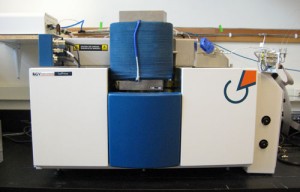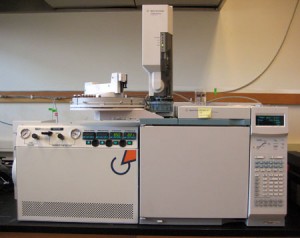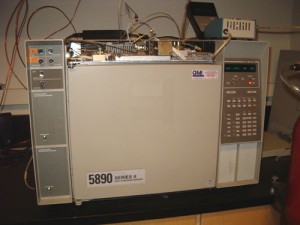Isoprime (GV Instruments) Isotope Ratio Mass Spectrometer (IRMS)
The IRMS is used for the determination of 15N and 13C in samples introduced via either the EA or GC by continuous flow. The IRMS is equipped with an ion source for ionizing the incoming sample gases, a permanent magnet and an electromagnet (1 – 70 AMU) for steering the ions, and three Faraday collector cups (carbon m/z 44, 45, 46; nitrogen m/z 28, 29, 30). A reference gas injector box is connected to the IRMS. The reference gas isotopic ratio is compared to the sample’s preliminary isotopic ratio during each sample run, and the sample’s final isotopic value is determined via a post-analysis two-point calibration using reference materials with known isotopic values. Final isotopic values are reported in the standard delta notation relative to air for nitrogen, and to Vienna Pee Dee Belemnite (VPDB) for carbon. Instrument precision is typically ± 0.3 ‰ for nitrogen and ± 0.2 ‰ for carbon.
Elementar Vario EL Cube Elemental Analyzer (EA)
The EA is used for the analysis of solid materials and can be used as a stand-alone instrument for the determination of wt. % N and C concentrations in samples, or coupled to the IRMS for 15N and 13C analysis.
The EA can be configured in either CN or N analysis modes, depending on the sample type. Samples are typically flash combusted at 950 ˚C and the gaseous combustion products are carried through a series of reactors and drying tubes that convert the sample gases to N2 and CO2 and remove water vapor. The N2 and CO2 are separated by a temperature-controlled CO2 absorbent trap before they reach the thermoconductivity detector, which can detect elemental concentrations and ratios from ppm levels to 100% (detection range for carbon: 0 to 40 mg absolute). For concentration determinations, blank sample capsules, and accurately weighed (± 0.001 mg) calibration standards (acetanilide or sulfanilamide) and certified reference materials (CRM) are interspersed amongst the samples. Final results are reported in wt. %N and wt. %C (or simply %N and %C). Instrument precision is about ± 3.0% for N and ± 1.5% for C (% relative standard deviation).
For EA-IRMS analysis, the sample gas stream exits the EA and continues on through an adjustable IsoPrime Diluter, which is interfaced between the EA and IRMS and can be used to dilute the CO2 sample gas stream whenever samples with high C:N ratios are encountered (e.g., organic materials). Certified reference materials USGS 40 and USGS 41 (L-glutamic acid; US Geological Survey) are typically used for the two-point calibration of final delta values, and other isotopic standards are inserted for quality assurance.
Agilent HP6890N Gas Chromatograph (GC)
The GC is used for the analysis of both liquid and gas samples. Currently, the GC is set up for the determination of 13C only and is not used as a stand-alone instrument. The GC is equipped with an Agilent 7683B Series liquid injector autosampler and a GV Instruments GC5 MKI combustion interface. The chromatographic column for dissolved fatty acid samples is an Agilent J&W HP-5 capillary column (length: 30 m, inner diameter: 0.32 mm, film thickness: 0.25 µm, max. temperature: 325 ˚C). The liquid samples are typically volatilized at 225 ˚C and the gaseous products are carried through the GC column where compounds are chromatographically separated via a user-defined temperature ramp method. Each compound is then combusted into CO2 at 850 ˚C in the furnace, and water vapor is removed by a Nafion membrane, before the sample gas enters the IRMS. Gaseous CO2 samples are injected into the GC inlet manually and do not require volatilization or combustion. An Agilent J&W HP-Plot Q capillary column (length: 30 m, inner diameter: 0.32 mm, film thickness, 20 µm, max. temperature 270 ˚C) can be used for gas samples, although we use the HP-5 column.
For PLFA and NLFA samples with natural isotopic abundance, certified reference materials C20:0 #2 and C20:0 #X (icosanoic methyl esters, University of Indiana) are used for the two-point calibration of final delta values. A bacterial acid methyl ester (BAME) standard is usually analyzed with each batch of samples for the identification of compounds and their retention times. The final isotope values for CO2 gas samples are compared against the CO2 reference gas isotopic value, which has been two-point calibrated using USGS 40 and 41.
Agilent HP5890 Series II Trace Gas Chromatograph (Trace GC)
The Trace GC is used for the analysis of the greenhouse gases CO2, CH4 and N2O. For CO2 and CH4 analyses, the Trace GC is equipped with a Restek PP-Q 80/100 stainless steel packed column (length: 3 ft, inner diameter: 2 mm), a methanizer operating at 325 ˚C, and a flame ionization detector (FID) operating at 300 ˚C. For N2O analyses, a Restek Porapak Q 80/100 stainless steel packed column (length: 6 ft, inner diameter: 2 mm) and an electron capture detector (ECD) operating at 350 ˚C are used. Gas samples are injected manually from a syringe connected via a sample injection inlet port.
Certified CO2, CH4 and N2O gas standards with known concentrations are diluted and analyzed to produce a calibration curve to determine the concentration of sample gases. The Trace GC is able to detect gases at normal atmospheric background concentrations in air (CO2: 390 ppmv, CH4: 1.8 ppmv, N2O: 0.33 ppmv).



